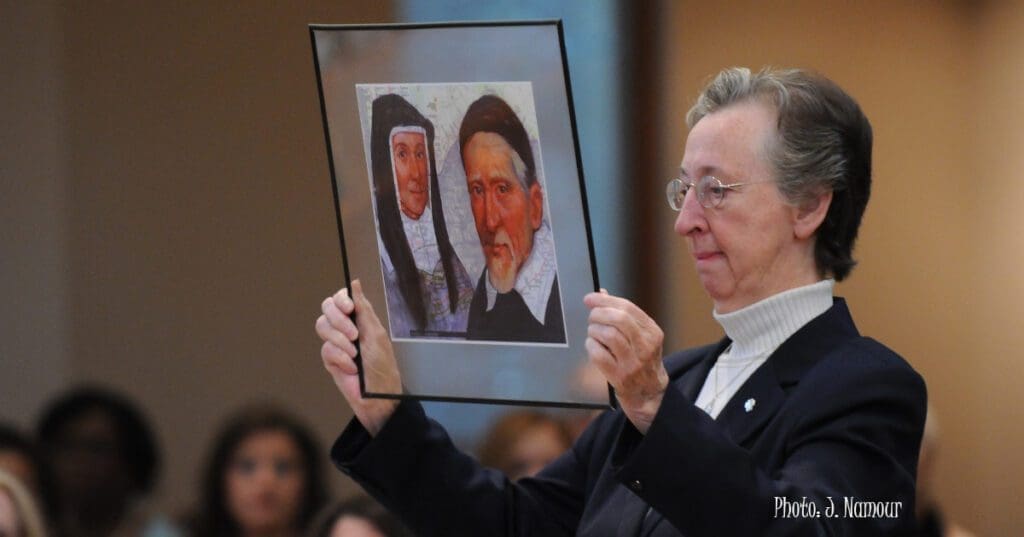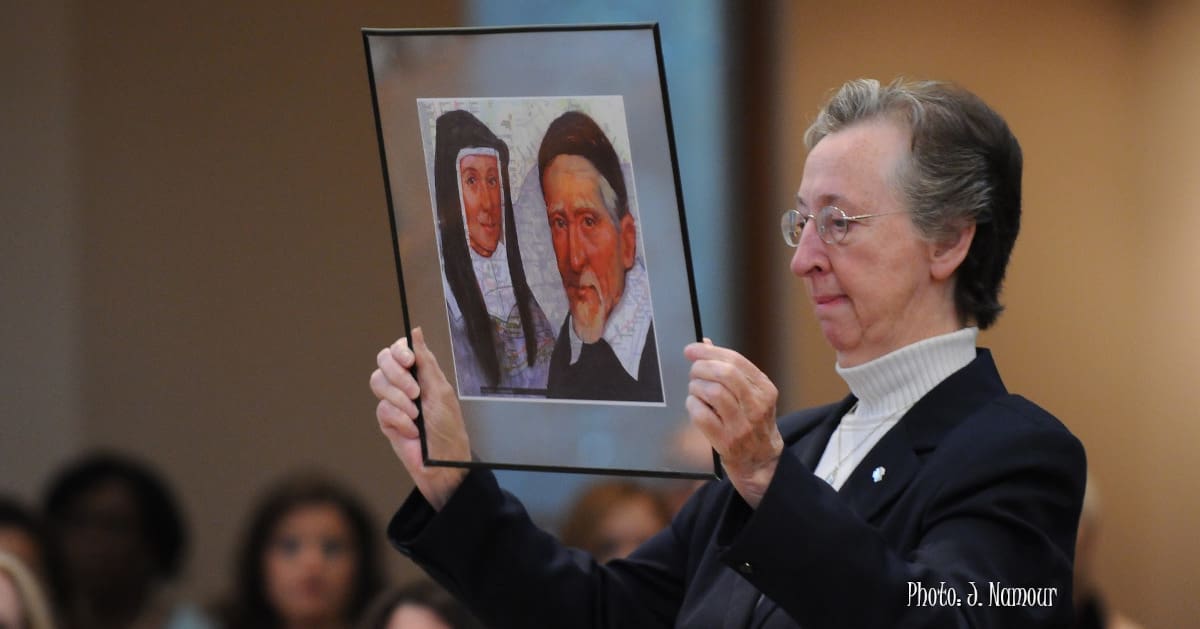The Way, the Truth, and the Life
St. John’s University commemorated the passing of Sr. Margaret John Kelly, D.C. ’64G, ’67Ph.D., the founder and former Executive Director of the Vincentian Center for Church and Society. Sr. Kelly, a devoted St. John’s faculty member and administrator, passed away at Villa St. Michael in Emmitsburg, MD, on November 24, 2022. A fuller treatment of her life and contributions is here. (link: https://www.stjohns.edu/news-media/news/2022-11-29/st-johns-university-mourns-loss-sr-margaret-john-kelly-dc-64g-67phd). A memorial Mass was held on May 7, 2023, at St. Thomas More Church on the campus of St. John’s University, Queens, U.S.A. Rev. Patrick J. Griffin, C.M., delivered the homily which follows.

Memorial Mass for Sister Margaret John Kelly, DC
St. John’s University
Sunday, May 7, 2023
“The Way, the Truth, and the Life”
I have little doubt that there are many stories about Sister Margaret John Kelly, DC in this room. (I alluded to that fact earlier.) Many of us knew her and in different ways. Nevertheless, this homily is not a eulogy. My intent is to allow the Gospel to drive our reflection and prayer as we gather on this Sunday in the Easter Season. That does not mean that there will not be some stories. . . .
I came to St. John’s in 2008 as the EVP for Mission. Among my responsibilities, there was the expectation that two women would report to me.
One was Pam Shea Burns. All of us who knew Pam would know that her answering to me would only be a pipedream. Pam was responsible for Campus Ministry, knew the job better than anyone, and was totally committed to our students. When Pam died some years ago, I spoke at her memorial service in this Church. I spoke about the windows.
The other woman was Sister Margaret John Kelly, DC. She was the Executive Director for the Vincentian Center for Church and Society. I liked Sister Margaret John very much and I had a genuine respect for her and her gifts. (And she was always Sister Margaret John to me—could you imagine me calling her Maggie or MJ or anything so informal.) I have already suggested her impressive credentials. But, honestly, I do not think that they meant much to her as matters of pride, they just describe how she utilized her talents. After meetings that we both attended, I could say to her: “Sister you walk into the room like you know that you are the smartest person in the room, (pause) and you are usually right.” She would laugh but without claiming the prize. Yet, she never left anything important unsaid and she did not fear disagreement—but you better make sure that you have your ducks lined up. I did.
One might truly and honestly describe her differently. But, let us turn to the Gospel and single out a phrase that gives a sense how she followed Jesus and offers a model for us as well.
In the Gospel, Jesus is speaking to his disciples. He says:
“Where I am going you know the way.”
Thomas said to him,
“Master, we do not know where you are going;
how can we know the way?”
Jesus said to him, I am the way and the truth and the life.
The three ways in which Jesus describes himself have particular meaning and application for me/us today—the Way, the Truth, and the Life. (The readings offer this passage to us three times this week—Wednesday, Friday and today. That sometimes makes me think of the movement of the Holy Spirit.) I also characterize these three elements—the Way, the Truth, and the Life—as embodying the roles of leader, teacher, and healer.
First of all, “the way.” This term arises three times in today’s Gospel. The Acts of the Apostles teaches us that early Christianity was described as “the way.” That idea may well stem from Jesus himself and this passage. Jesus is speaking to the disciples about the fact that he is leaving them, but that they will soon come to where he is because they know “the way.” Thomas is surprised at this.
However, Jesus chooses to expand the thinking of the disciples. He tells them something that he has often said in John’s Gospel: Jesus himself needs to be their focus. He is not interested in maps, plans, or doctrine. He is interested in the personal confidence that the disciples must place in him. He says clearly: “I am the way, and the truth, and the life.” It is not knowing the route that is most important, but following Jesus. It is not in memorizing some careful definitions of the truths of our faith that leads to the source of all wisdom, but in knowing Jesus. Believing in a heaven or hell does not lead to eternal life, but in yearning to be with Jesus. It all comes back to Jesus.
Vincentians find and walk the Way of Jesus according to the modeling of Vincent de Paul and Louise de Marillac. Their attention to his words, their celebration of the sacraments, their understanding of his reverence for people—especially the poor—characterize their mission and charism. The members of the Company and the Congregation follow this Way. Vincent told us “Christ is the rule (the way) of the mission.” Jesus is the way that we move forward, and his particular attention to those who are in need defines the direction and the pace. We might characterize this as “leadership” and Sr. Margaret John was familiar with this particular aspect of the Christian mission that requires dedication and application. It was a manner in which she expressed her faith. She did not shy away from making decisions or leading along the path in her following Christ as “the way.”
In addition, Jesus proclaims “I am the Truth.” I associate this with the teaching role of Jesus. Jesus focuses upon this principle: “For this I was born and for this I came into the world, to testify to the truth. Everyone who belongs to the truth listens to my voice.” (Jn 18:37). He has neither time nor patience for compromise or hidden elements. When Jesus speaks to people, he invites them to confront the reality about themselves and our world. He does so with great compassion and understanding, but he always wants to reveal and deal with the genuine in a person’s life. If they need to repent, he speaks the words of forgiveness. If they want to reexamine the priorities in their lives, he readily offers recommendations and direction. If they seek answers, he suggests better questions and issues. Jesus consistently directs himself towards uncovering and proclaiming the truth. The religious leaders of his time would have been a lot happier with him if he would have been less absolute, but that was not his way. Prepared to speak the truth, he would embrace whatever consequences arose from this decision. He speaks about himself as the “true bread which came down from heaven,” as the “true vine.” Accepting Jesus always moves one towards seeking and living with the truth. This is the role of a teacher and education to seek and express the truth.
We know the value that Sr. Margaret placed upon education. She thought that the poor could truly be served in this way, as they were given the knowledge to move up the social ladder. Clearly, Vincent and Louise gave great emphasis to education as well. This means of serving the poor keeps on giving. It rests at the heart of the foundation of St. John’s University to which Sr. Margaret John was such a generous contributor. Again, we hear from John’s Gospel.
“If you remain in my word, you will truly be my disciples,
and you will know the truth, and the truth will set you free.” (Jn 8:31-32)
Finally, Jesus tells us that he is “the Life.” We know how he speaks to us about being the “bread of Life,” about being the “life-giving water.” The New Testament imagery surrounds the ministry of Jesus with words carrying the gift of life. Jesus gives life not simply in the raising from the dead, but in the restoration of sight, in the strengthening of crippled limbs, and in the revival of hearing. He gives life in the elimination of hunger, the casting out of demons, and the restoration of dignity. He gives life by the stories that he tells, by the challenges that he presents, and by the invitations that he offers. In countless ways, Jesus brings healing and fullness of life.
Vincentian history tells us how healing was one of the earliest ministries of the Ladies of Charity and the Daughters of Charity. The desperate needs of the poor for someone to minister to them respectfully and competently drew the attention and action of Vincent and Louise. It has been a regular part of the ministry of the Daughters of Charity as well. Sister Margaret John intimately embraced this particular kind of service and the needs of the poor for better and compassionate care. Her contribution at St. John’s to the Catholic Health System, her writing, and her place on so many healthcare Boards provided a way for her to attend to this need of the poor.
Yes, Jesus describes himself to Thomas and to us as “the way and the truth and the life.” We thank God for the way in which Sr. Margaret John Kelly responded to the demands of this identity and offered us an example. We ask our loving God to give her the reward of her labors. We also ask that we might recognize the need for us to be leaders, teachers and healers in our world. With these means we follow our Christ who has shown us how to be true disciples and in a Vincentian way.
Tags:







Wonderful homily: filled with the Gospel and Sr. Margaret John too…
A beautiful reflection that challenges each of us to live more deeply the Vincentian Charism. Sister Margaret was for many not only, leader and witness to this charism, teacher and healer but also mentor and friend. She is missed by many.